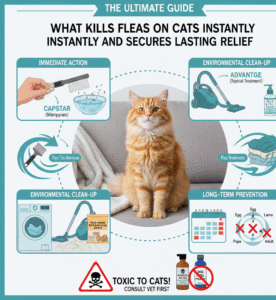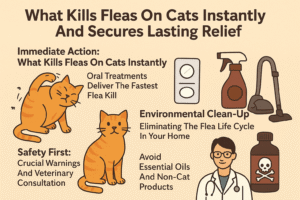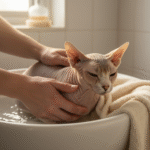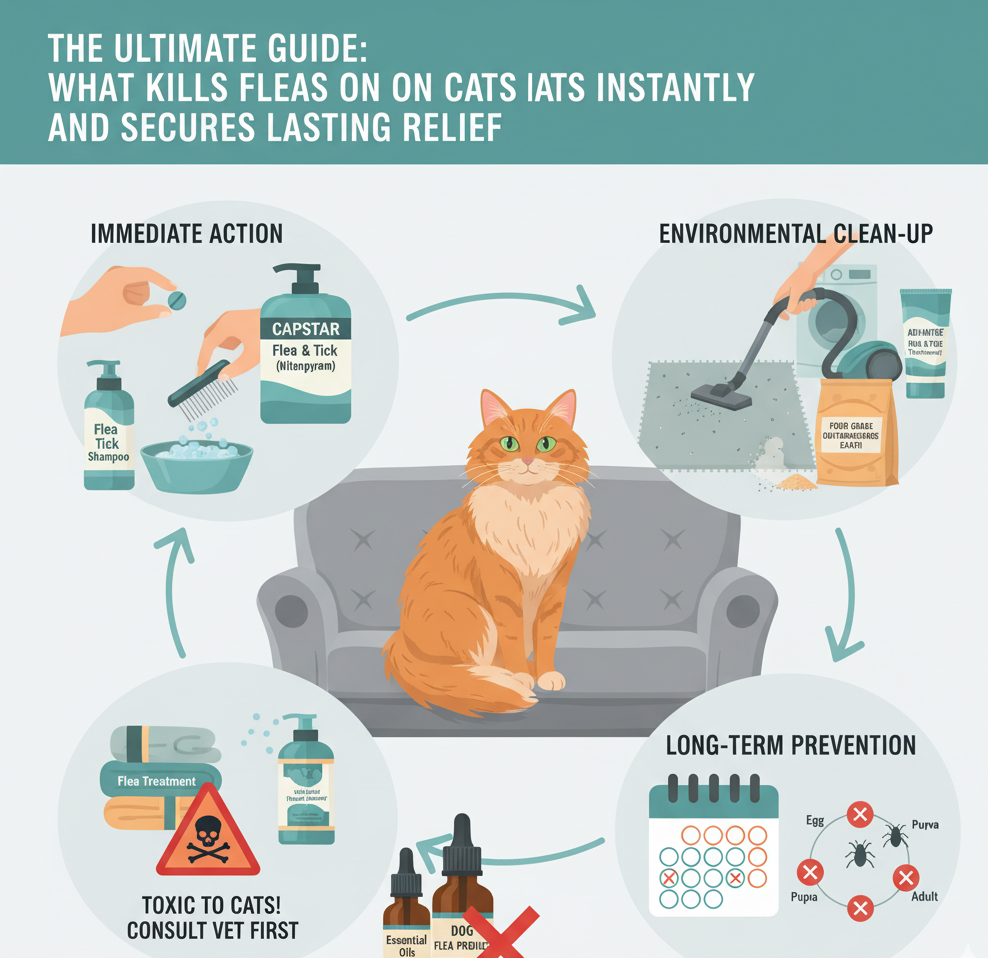Want to know what kills fleas on cats instantly? Learn about quick and safe treatments like Capstar, flea shampoos, and topical solutions. This easy guide explains how to give your cat fast relief, keep your home flea-free, and prevent those pesky pests from coming back — all while keeping your furry friend safe and happy.
A flea infestation on your beloved cat triggers immediate alarm. You watch your feline friend scratch frantically, a picture of misery, and you desperately search for a fast, effective solution. Understanding what kills fleas on cats instantly becomes your top priority, moving you from panicked pet owner to proactive health manager. Fleas pose more than just an annoyance; they can transmit tapeworms, cause skin allergies, and in severe cases, even lead to anemia, especially in kittens. Therefore, swift and comprehensive action is non-negotiable.
We break down the most effective, vet-approved methods for achieving rapid flea kill, ensuring you not only eliminate the current crisis but also establish a robust, long-term defense strategy. Tackling fleas successfully requires a multi-pronged approach, simultaneously treating your cat and eradicating the unseen infestation in your home. You must move quickly and deliberately, employing treatments that work fast and safely. Remember, immediate relief is crucial, but only a complete strategy—covering chemical treatments, physical removal, and environmental cleansing—truly solves the problem.
Immediate Action: What Kills Fleas On Cats Instantly
When you need an immediate halt to the flea crisis, only a few proven methods deliver the knockdown power you require. These solutions offer distinct advantages, working on different timelines and through different mechanisms. You must choose the right tool for the job, carefully considering your cat’s health, age, and the severity of the infestation. Consulting your veterinarian remains the most important first step before administering any potent flea-killing product. They know your cat’s history and can recommend the safest, most effective prescription or over-the-counter options for your specific situation.
Oral Treatments Deliver The Fastest Flea Kill
Oral medications represent one of the fastest routes to immediate relief, working from the inside out. These powerful tablets circulate rapidly through your cat’s bloodstream, killing adult fleas as they bite. This method effectively transforms your cat’s blood into a lethal dose for the parasites, eliminating the adult population quickly.
Capstar (Nitenpyram) Tablets: What Kills Fleas On Cats Instantly Within Minutes?
Capstar, a brand name for the active ingredient nitenpyram, stands as the unrivaled champion of speed. Pet owners universally praise this product for its astonishing knockdown power. This oral tablet delivers a paralyzing blow to adult fleas.
- Mechanism of Action: Nitenpyram is a neonicotinoid, which attacks the central nervous system of the flea. The adult fleas become hyper-stimulated and then die. The speed of action is its most notable feature, giving your cat near-instant relief.
- Timeline: Capstar (nitenpyram) tablets kill adult fleas on cats within 30 minutes. You will often see fleas dropping off the cat as soon as 15 minutes after administration, a visible, highly satisfying sign that the treatment works immediately.
- Key Consideration: Capstar’s effect is fast but fleeting; it eliminates adult fleas but offers no residual protection. You must follow up with a long-term preventive treatment (a separate medication) to prevent new fleas from hatching in the environment and reinfesting your cat. Veterinarians often use Capstar as a first-line “knock-down” agent in combination with a long-acting topical or oral preventive.
Topical Treatments Provide Fast Relief And Residual Protection
Topical spot-on treatments offer a dual benefit: they provide quick initial relief and continue killing fleas for an extended period, typically one month. You apply the liquid formula directly to a small area of skin, usually between the shoulder blades, and the active ingredients spread across the cat’s skin oils. This method attacks fleas on contact, offering both treatment and future prevention.
Popular Spot-Ons: Frontline, Advantage, Or Revolution
Many trusted brands utilize powerful, fast-acting compounds that kill adult fleas and also interrupt the flea life cycle by eliminating eggs and larvae. You rely on these products for both rapid treatment and reliable month-long prevention, making them a crucial part of your overall flea management strategy.
- Frontline (Fipronil and S-Methoprene): Fipronil kills adult fleas, while S-methoprene acts as an Insect Growth Regulator (IGR), preventing flea eggs and larvae from developing.
- Advantage (Imidacloprid): Imidacloprid targets the flea’s nervous system, causing rapid death. You observe a quick reduction in the flea population, often within hours.
- Revolution (Selamectin): This prescription-only medication offers protection against fleas, heartworms, and other parasites. Selamectin enters the bloodstream and kills adult fleas, providing comprehensive parasite control.
Topical flea treatments like Frontline, Advantage, or Revolution provide fast relief while establishing a month-long defense shield against reinfestation. Always apply these products correctly, directly to the skin, and ensure you purchase the correct formula and dosage for your cat’s weight and species.
Physical Removal And On-Contact Elimination
While chemical treatments offer the best systemic kill, immediate physical and topical action can provide crucial relief, especially for cats that are too young, too frail, or too sensitive for strong chemical treatments. These methods remove fleas on contact, providing instantaneous, albeit temporary, relief.
Flea Shampoos And Baths: Killing Fleas On Contact
A bath offers a straightforward, immediate way to wash fleas and flea dirt down the drain. The water itself immobilizes many fleas, and the active ingredients in the shampoo then quickly dispatch them. This method is particularly effective for heavily infested cats where you need a large-scale, immediate purge.
- Action: Flea shampoos with safe, vet-approved ingredients can kill fleas on contact. Look for shampoos formulated specifically for cats and containing pyrethrins (natural insecticides) or insecticidal soaps. Ensure the product is safe for the feline species.
- Technique: Lather the cat thoroughly, paying special attention to the neck area first to prevent fleas from migrating to the head. Leave the lather on for the time specified on the label before rinsing.
- Note on Speed: Although instantaneous on contact, the process of bathing an entire cat is time-consuming and often stressful for the animal, making it less convenient than a quick pill or spot-on application.
Flea Combing: Immediate, Non-Chemical Removal
The flea comb represents the most non-toxic, immediate, and hands-on method of physical removal. You actively comb through the fur, lifting live fleas, flea eggs, and flea dirt from the coat. This method provides direct, instantaneous results.
- Action: Flea combing removes live fleas and eggs immediately from the fur. The fine teeth of the comb physically trap the parasites and eggs.
- Technique: Dip the comb into a cup of hot, soapy water (dish soap works well) after each pass. The soapy water breaks the flea’s surface tension, trapping and drowning it instantly. You must meticulously comb the entire cat, focusing on the neck, tail base, and belly.
- Benefit: For kittens or pregnant/nursing cats, where chemical options are limited, combing becomes a vital, safe tool for instant flea removal.
Environmental Clean-Up: The Critical Second Pillar Of Flea Control
You must recognize that only about 5% of the total flea population lives on your cat; the other 95%—the eggs, larvae, and pupae—reside in your home environment. Therefore, treating the cat addresses only the visible problem. To truly stop the cycle, you need a comprehensive environmental clean-up. This part of your strategy ensures your pet does not immediately become re-infested by newly hatched fleas.
Eliminating The Flea Life Cycle In Your Home
The flea life cycle is a continuous, self-perpetuating loop. To break it, you must target all stages dwelling in your carpets, furniture, and bedding. You will never achieve long-term success unless you address the domestic reservoir of the flea population.
Deep Cleaning Textiles To Remove Fleas
Fleas and their eggs hide deep within fabrics. Your washing machine and vacuum cleaner become your primary weapons in this crucial environmental battle.
- Cat Bedding: Wash cat bedding and vacuum carpets to remove fleas and larvae from the environment. Wash all pet bedding, blankets, and any cushion covers your cat uses in the hottest water the fabric can tolerate. The high heat effectively kills all life stages of the flea. You should repeat this washing process regularly (weekly) for several weeks following the initial infestation to catch any newly hatching larvae.
- Vacuuming: You must aggressively vacuum all carpets, rugs, upholstered furniture, and cracks in the floorboards. The vibration of the vacuum cleaner often encourages pre-emerged adult fleas to hatch from their protective pupal cocoons, making them susceptible to being vacuumed up. Always immediately dispose of the vacuum bag (or empty the canister outside into a sealed trash bag) to prevent the fleas from crawling back out.
Natural Aids: Using Diatomaceous Earth
For an environmentally conscious option, food-grade diatomaceous earth (DE) offers an effective, non-chemical way to kill fleas in the home environment. You use it as a desiccating agent that dehydrates the parasites.
- Mechanism: Diatomaceous earth (food-grade) can kill fleas naturally by dehydrating them. DE consists of the fossilized remains of diatoms, tiny aquatic organisms. Its particles are microscopic, razor-sharp cylinders. When fleas crawl over the fine powder, the sharp edges cut through the waxy, protective outer layer of the flea’s exoskeleton, causing them to dry out and die.
- Application: Lightly dust carpets, cracks, and crevices in your home. Let it sit for a few hours or overnight, and then vacuum it up thoroughly. Ensure you use only food-grade DE and avoid inhalation by wearing a mask during application. You should apply it with caution to areas where your cat cannot lick or inhale large quantities.
Safety First: Crucial Warnings And Veterinary Consultation
While your instinct screams for speed and power in treating fleas, you must always prioritize your cat’s safety. Many products effective for dogs or other pests are highly toxic to felines, and misapplying even the right product can have severe or fatal consequences. A successful flea treatment is one that is both effective and safe.
The Essential Role Of Your Veterinarian
Never underestimate the importance of professional advice. Your vet provides indispensable guidance, ensuring you choose a treatment that works instantly without compromising your cat’s health.
Always Consult Your Vet Before Treatment
Before you apply any spot-on, administer an oral tablet, or purchase a flea collar, you consult your vet before using any instant flea-killing product. They will confirm the nature of the infestation, rule out other skin conditions, and recommend a weight-appropriate, species-specific treatment plan. They also determine if your cat’s current health status or any other medications interact negatively with a fast-acting flea product. Only a vet can authorize certain prescription-strength medications, which often represent the most effective and safest options on the market.
Toxic Warnings: Essential Oils And Non-Cat Products
Feline physiology differs significantly from human or canine physiology, especially in the way they metabolize certain chemical compounds. Cats lack a key liver enzyme (glucuronosyltransferase) necessary to process certain organic compounds, including many ingredients in essential oils.
- Warning: Avoid essential oils (like tea tree or eucalyptus)—they are toxic to cats. Exposure to these oils, whether through topical application, inhalation, or ingestion, can cause liver damage, seizures, difficulty breathing, and even death. Never use products designed for dogs on your cat, as dog flea treatments often contain permethrin, a potent neurotoxin for cats. You must read every product label carefully.
The Long Game: Preventing Future Flea Infestations
Instant relief solves the crisis of the moment, but it cannot prevent the next infestation. Fleas reproduce at an astonishing rate. A female flea lays up to 50 eggs per day, meaning a handful of fleas can rapidly become an overwhelming population. You must move from crisis management to a consistent, proactive prevention schedule to safeguard your cat long-term.
A Three-Part Strategy For Permanent Flea Eradication
Permanent freedom from fleas relies on a complete, MECE framework (Mutually Exclusive, Collectively Exhaustive) that covers every phase of the flea life cycle and every area of potential infestation.
Treating The Cat and The Home Simultaneously
You must treat the cat and the home concurrently to ensure a complete break in the flea life cycle. Failure to address one area results in immediate reinfestation from the other, an overlap that makes your efforts redundant.
- Cat Treatment: You administer the fast-acting and long-lasting treatments as recommended by your vet.
- Home Treatment: You deep clean, vacuum, and potentially treat the home with an IGR spray. You treat your home (not just the cat) to stop reinfestation. This step ensures you eliminate the environmental reservoir of eggs and larvae.
Establishing A Consistent Prevention Schedule
Consistency is the single most important factor in long-term flea control. Fleas thrive year-round in many climates, making continuous treatment non-negotiable.
- Monthly Treatments: Repeat prevention treatments monthly to keep fleas away long-term. Use the long-acting spot-on or oral preventive medication every 30 days, without fail. Mark your calendar and stick to the schedule. A single missed dose can create a gap where a few newly introduced fleas can start the entire infestation cycle all over again.
Frequently Asked Questions About What Kills Fleas On Cats Instantly
Pet owners inevitably have crucial questions regarding the speed and safety of flea treatments. We address the most common inquiries, providing the clarity you need to act decisively and safely.
How Does Capstar Kill Fleas So Quickly?
Capstar’s active ingredient, nitenpyram, is a systemic insecticide that targets the adult flea’s central nervous system. When the flea bites your cat, it ingests the compound, which acts immediately to overstimulate and paralyze the flea, causing it to drop off and die. It works within minutes because the drug absorbs into the bloodstream rapidly. This speed is what makes it a powerful answer to what kills fleas on cats instantly.
Can I Use Dish Soap To Instantly Kill Fleas During A Bath?
Yes, dish soap (like Dawn) kills fleas instantly. Dish soap works not because of harsh chemicals, but because it is a powerful degreaser and surfactant. It breaks the flea’s natural surface tension and protective outer coating. The flea relies on this surface tension to float and move in water. By breaking it, the soap quickly drowns and immobilizes the fleas on contact. However, while instantly effective, a dish soap bath does not provide any residual killing power or protection, unlike a veterinary-approved medicated shampoo or topical.
How Long Does It Take For Flea Eggs In The Home To Hatch?
The full flea life cycle—from egg to adult—can take anywhere from two weeks to several months, depending on environmental conditions like temperature and humidity. The eggs themselves typically hatch within two to 12 days. This is why immediate treatment of the cat and environment is so vital, and why you must consistently repeat prevention treatments monthly to keep fleas away long-term. Ignoring the environmental stage means you continually allow new adults to emerge and re-infest your cat.
Is Diatomaceous Earth Safe To Use Directly On My Cat To Instantly Kill Fleas?
You should exercise extreme caution when applying diatomaceous earth (food-grade) to kill fleas naturally. While food-grade DE is non-toxic if ingested in small amounts, its ultra-fine particles pose a serious risk if inhaled by both you and your cat. It can irritate the lungs and respiratory system significantly. Vets generally recommend you use DE only sparingly as an environmental treatment, sprinkled lightly on carpets and vacuumed up later, rather than applied directly to your cat’s fur where they may inhale or ingest large amounts while grooming. Stick to vet-approved topical or oral products for direct-to-cat treatment.
Conclusion: A Total Strategy For Total Victory
Successfully eliminating a flea infestation requires you to implement a total, zero-tolerance strategy. You need to combine the instant, high-impact power of treatments like nitenpyram, which clearly answers the question of what kills fleas on cats instantly, with the sustained, preventative defense of topical treatments like Frontline or Advantage. Furthermore, you cannot skip the critical environmental cleanup; you must diligently wash cat bedding and vacuum carpets to remove fleas and larvae from the environment.
Your active, comprehensive approach must be both Mutually Exclusive and Collectively Exhaustive (MECE), meaning you attack all life stages (adult, egg, larva, pupa) without redundant effort, and you cover all areas (the cat and the home) without leaving any gaps. Always consult your veterinarian before starting any treatment plan, avoiding dangerous shortcuts like essential oils. By committing to this three-part strategy—Immediate Kill, Environmental Eradication, and Long-Term Prevention—you ensure your cat enjoys lasting relief and remains protected from the detrimental effects of future flea infestations.











